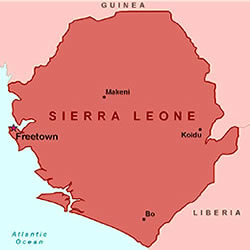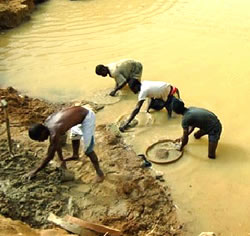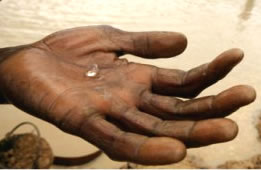|
Reviewed By Andreas Zabczyk
Sierra Leone's Diamonds Map of Sierra Leone
West Africa is one of the most important sources of diamond in the world; in fact, these precious gemstones have earned a fearsome reputation for funding wars and caused worldwide concern. One West African nation which bears the scars of a long civil war is Sierra Leone. Established as a trading post, and then annexed by the British, Sierra Leone gained independence in 1961. After several years of democratic rule, mounting unrest resulted in civil war. The illegal trade of diamonds from Sierra Leone to Liberia helped to fuel the war from 1991 until 2002. Despite its mineral wealth in diamonds, titanium, gold, bauxite and rutile, a large proportion of the population are impoverished. The capital of Sierra Leone is Freetown. With its large natural harbor where the Sierra Leone River Estuary meets the Atlantic Ocean, the mineral-rich nation is well-placed for international trade. This geographical feature that allowed much to be taken away from Sierra Leone in the past could help to bring some fortune back to the country. This began when the capital was first established as the "Province of Freedom" in 1787 by the British to settle liberated African American slaves who originated from various regions of Africa. Freetown is blessed with white sand beaches on one side and lush mountains on the other. It is a colorful and lively city which is the educational, economic and political hub of Sierra Leone.  Alluvial Mining for Gems in Sierra Leone
Diamonds can be mined in several ways, one of which is open pit mining, whereby a large hole is made in the earth and diamond-rich material is removed and sorted. Open-pit or open-cast mining is suitable for deposits that lie near the surface. Underground mining uses a system of tunnels under the ground, and can follow open-pit mining when the deposit is sufficient. Diamonds are also mined from the sea bed, either by drilling into the ocean floor or by extracting surface gravels. Lastly, alluvial mining is performed when diamond deposits are transported by rivers, before they reach the sea. This is also called placer mining. Alluvial mining can be carried out by people with simple tools, and it is believed that most of the alluvial mining in Sierra Leone has been performed by artisanal miners, before the Kimberley Process was imposed. Diamond mining in Sierra Leone has been documented since the 1930s. The main technique for recovering the diamonds is alluvial mining. The most important areas of diamond mining are in the east and southeast of the country, in particular, Kono District, which produces more diamonds than other areas of Sierra Leone. Most of the operations were small-scale until fairly recently, when large companies began to produce diamond from the area, despite problems with electricity, transportation and sanitation. An amazing discovery was made in 1943 in Koidu; the capital city of Kono District. A 770-carat diamond was unearthed from the river gravel. This was the largest alluvial diamond to be discovered until the 968.9-carat "Star of Sierra Leone" was found 25 years later, also in Koidu. Visitors to Kono will notice that it somewhat resembles a goldrush town; the roads are not yet tarmacked and it is a work in progress. The dusty streets are potholed and despite its long history of diamond mining, it is still emerging from the ravages of civil war.  White Diamond from Sierra Leone
While diamond production and the long-term economy remains promising, the 2015 drop in the price of iron ore led to some disappointment. Sierra Leone has more than its fair share of the world's problems; high maternal and infant mortality rates, Ebola, unemployment and a war-ravaged infrastructure that makes it hard to imagine how this nation will recover. Yet, without despair, there is no hope, and for Sierra Leone, life must go on. For many of the unemployed, digging in the dirt for diamonds or gold is the only hope they have. The situation is slowly beginning to change; with political stability and reform come foreign investment, and the employment offered by investors is a welcome change. As the country begins to prosper, the much-needed revenue acquired should help to put back in what has been savagely taken from Sierra Leone. This Page in Other Languages
|
| STAY IN TOUCH | NEWSLETTER |
| *You're signing up to receive GemSelect promotional email. |
Copyright © 2005-2024 GemSelect.com all rights reserved.
Reproduction (text or graphics) without the express written consent of GemSelect.com (SETT Company Ltd.) is strictly prohibited.
2712